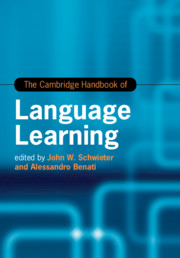Book contents
- The Cambridge Handbook of Language Learning
- Cambridge Handbooks in Language and Linguistics
- The Cambridge Handbook of Language Learning
- Copyright page
- Contents
- Figures
- Tables
- Contributors
- Acknowledgements
- Introduction
- Part I Theories
- Part II Methods
- Part III Skill Development
- Part IV Individual Differences
- Part V Pedagogical Interventions and Approaches
- Part VI Context and Environment
- Part VII Moving Forward
- 32 Future Directions in Language Learning and Teaching
- Index
- References
32 - Future Directions in Language Learning and Teaching
from Part VII - Moving Forward
Published online by Cambridge University Press: 25 June 2019
- The Cambridge Handbook of Language Learning
- Cambridge Handbooks in Language and Linguistics
- The Cambridge Handbook of Language Learning
- Copyright page
- Contents
- Figures
- Tables
- Contributors
- Acknowledgements
- Introduction
- Part I Theories
- Part II Methods
- Part III Skill Development
- Part IV Individual Differences
- Part V Pedagogical Interventions and Approaches
- Part VI Context and Environment
- Part VII Moving Forward
- 32 Future Directions in Language Learning and Teaching
- Index
- References
Summary
Looking into a crystal ball is a difficult task, but one that gives me leeway to take a broad view of the field and “think aloud” about where the future might take us. It is a dangerous task because within a year of publication (or less), it is likely that I will already be proven wrong. Nonetheless, I will attempt to take the pulse of the field as it was in the past, as it is today, and as it might be in the future. This paper has three parts. In the first part, I will look at the field historically and consider: (1) the relationship between language teaching and learning; (2) the overall growth of the field of second language acquisition (SLA) and its increasing distance from language teaching and the resulting quest for disciplinary identity; and (3) changes in emphases that suggest a narrowing of the gap.
- Type
- Chapter
- Information
- The Cambridge Handbook of Language Learning , pp. 777 - 798Publisher: Cambridge University PressPrint publication year: 2019
References
- 2
- Cited by



